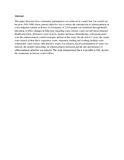| dc.description.abstract | This paper illustrates how community participation was achieved in a study that was carried out between 1983-1988 whose general objective was to reduce the transmission of schistosomiasis in a rice irrigation scheme in Kenya. A community of 2,219 people was mobilized through health education, to effect changes in behaviour regarding water contact, water use and faecal disposal. Health education, alternative water sources, latrines and mass chemotherapy with praziquantel were the schistosomiasis control strategies utilized in this study. By the end of 2 years, the canals were cleared of their thick vegetation, water, sanitation, bathing and washing facilities were constructed, water contact with infective waters was reduced, faecal contamination of water was reduced, the people's knowledge on schistosomiasis increased and the rate and intensity of schistosomiasis infection was reduced. The study demonstrated that it is possible to fully involve the community in disease control efforts. | en_US |

